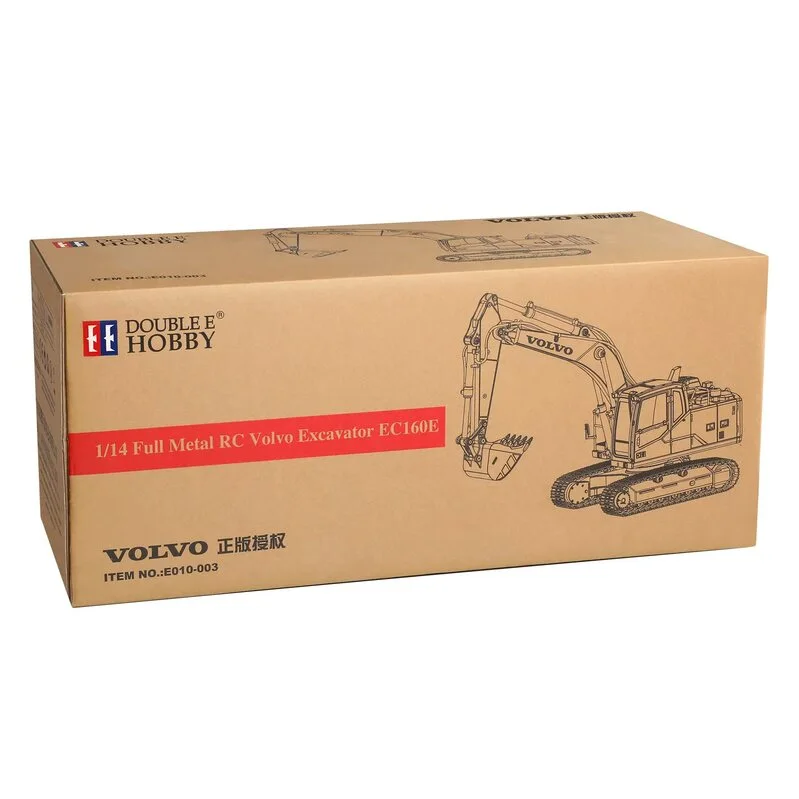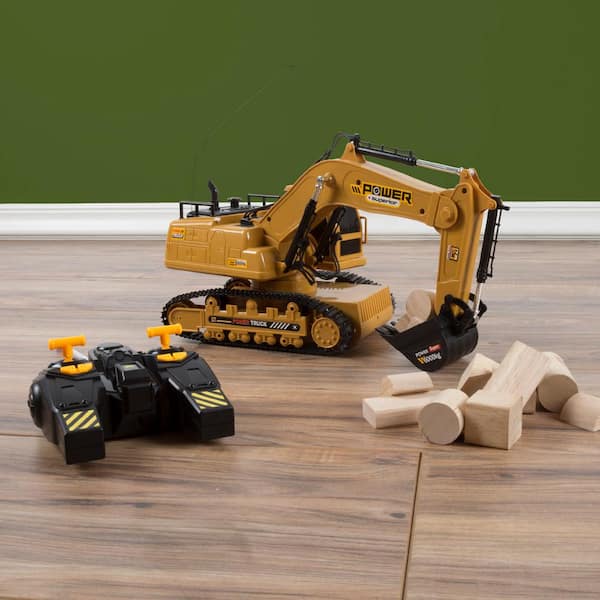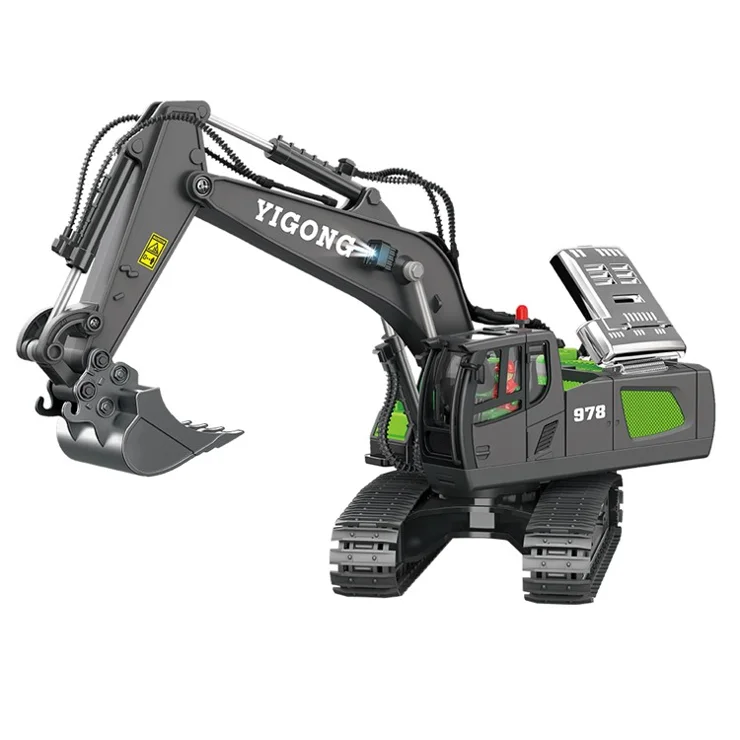Key Tips for Maximizing Efficiency with a rc excavator
Wiki Article
The Necessary Attributes of Excavator That Make It a Must-Have Device
Excavators are crucial in the building and landscape design markets. Their versatile attachments enable a variety of tasks, from digging to demolition. Furthermore, they boast remarkable digging depth and reach, powered by robust engines. Operator comfort and small styles improve functionality in different atmospheres. What truly sets excavators apart are their advanced hydraulic systems and longevity. Understanding these features can make clear why they are thought about vital devices on any job site.Versatile Attachments for Enhanced Performance
Excavators are powerful machines on their own, the addition of flexible add-ons significantly enhances their functionality. These attachments transform a standard excavator right into a multi-purpose device, ideal for a variety of tasks. Buckets, for instance, come in different sizes and shapes, allowing drivers to dig, scoop, and relocate materials efficiently. Hydraulic thumbs can be added for improved gripping and handling of cumbersome products, such as logs or rocks.Furthermore, specialized add-ons like breakers and augers permit boring and demolition job, expanding the excavator's energy on building and construction websites. remote control excavator. Grapples are one more option, suitable for arranging and relocating debris. This adaptability not just enhances productivity however likewise minimizes the need for several machines, saving time and prices. By gearing up excavators with the ideal accessories, drivers can deal with diverse projects, making them essential in the building marketSuperior Excavating Deepness and Reach
Excavators are developed with premium excavating depth and reach, allowing them to maneuver in tight spaces and access hard-to-reach locations. This capacity is crucial for various building and excavation jobs, where conventional equipment may fail. With flexible boom arms and extendable tracks, excavators can quickly browse uneven surface while keeping stability.The digging deepness can vary considerably among versions, frequently varying from 10 to 25 feet, relying on the design and function. This feature allows drivers to dig deep into structures, trenches, and various other deep frameworks successfully. Furthermore, the reach of an excavator enables for specific digging and material handling without repositioning the machine regularly, saving time and labor costs.Ultimately, the remarkable digging depth and reach of excavators make them indispensable for experts seeking to complete complicated jobs with accuracy and efficiency. Their flexibility improves efficiency on job sites, showcasing them as a crucial device in modern construction.Powerful Engine Efficiency

When it concerns performance and productivity on building sites, effective engine efficiency plays a pivotal role in the capacities of an excavator. A durable engine produces significant horse power, permitting the device to deal with durable tasks effortlessly - remote control excavator. This stamina converts right into faster cycle times, allowing operators to full tasks extra quickly.Additionally, powerful engines provide the needed torque to take care of challenging terrains and varied lots, ensuring that the excavator can execute successfully under various conditions. Whether it is raising, excavating, or relocating materials, the engine's efficiency directly influences the general operational performance of the machine.Furthermore, developments in engine modern technology have actually led to improved gas performance, lowering functional costs while maintaining power outcome. Ultimately, the engine's performance serves as the backbone of an excavator, attesting its standing as a vital tool in the building sector
Advanced Hydraulic Equipments

Boosted Raising Ability
A considerable enhancement in raising ability can be connected to innovative hydraulic systems located in modern-day excavators. These systems utilize high-pressure fluid to produce higher force, allowing drivers to raise larger tons easily. The design behind these hydraulics assurances peak performance, supplying an outstanding power-to-weight proportion that improves total effectiveness. Because of this, excavators can take on demanding tasks, such as lifting huge materials or equipment, without compromising stability. Furthermore, the robust layout of hydraulic elements adds to enhanced resilience and reliability, making them suitable for various building settings. This boosted training ability not only lowers the time required for jobs yet also decreases the need for added equipment, showing essential for both performance and cost-effectiveness in the building industry.Enhanced Precision Control
Conventional excavators frequently had a hard time with precision, modern hydraulic systems have transformed control mechanisms, making it possible for drivers to perform tasks with remarkable precision. These sophisticated systems utilize symmetrical control valves that permit for smoother and more responsive activities, substantially lowering the margin for error. Operators can now carefully tune the excavator's movements, making it simpler to browse tight rooms and deal with fragile products. Improved feedback systems further notify operators of real-time efficiency, guaranteeing ideal coordination in between the maker and operator. This boosted accuracy not just boosts performance but also boosts safety on work websites, reducing the danger of crashes. Consequently, modern excavators outfitted with advanced hydraulic systems are very useful devices for building and construction and excavation jobs requiring precise accuracy.Driver Comfort and Presence
Operator convenience and visibility are crucial components in the style of modern excavators (remote control excavator). Attributes such as ergonomic seat layout, boosted exposure choices, and effective control formats substantially enhance the driver's experience and efficiency. Focusing on these aspects assurances that drivers can work efficiently and securely in numerous problemsErgonomic Seat Layout
Comfort and visibility are extremely important in excavator layout, with the ergonomic seat playing a necessary role in improving the driver's experience. An ergonomic seat is crafted to support the operator's body, minimizing tiredness throughout long hours of operation. Adjustable functions, such as seat height, back-rest angle, and lumbar assistance, satisfy private choices and promote suitable stance. These changes enhance comfort and make it possible for the operator to keep concentrate on tasks without discomfort. In addition, a well-designed seat can supply better side assistance, permitting smoother maneuvering when the excavator functions. This thoughtful design not only improves performance yet additionally adds to general safety and security, making sure that drivers can execute their tasks successfully and successfully.Boosted Presence Functions
The layout of an excavator expands past just the seat, with improved presence functions playing a significant role in driver comfort and general security. Big home windows and tactically located mirrors give drivers with a clear sight of their surroundings, reducing dead spots. This layout factor to consider enables far better spatial recognition, which is essential in busy work environments. Additionally, many excavators incorporate rearview cameras and progressed surveillance systems that aid drivers in maneuvering tight spaces. The integration of these visibility features not only promotes safety but also decreases operator fatigue by making it possible for much easier tracking of workspace. Inevitably, improved visibility adds to extra effective procedures and assists guarantee that excavators can execute their tasks effectively and securely.Control Format Effectiveness
While maneuvering facility work websites, a reliable control design substantially improves both driver comfort and presence. A properly designed control setup warranties that operators can access important features with minimal effort, reducing tiredness throughout long hours. Ergonomic joystick positionings and instinctive button setups enable for smooth operation, making it possible for operators to keep concentrate on the task handy. Additionally, clear presence of both the workplace and the control board is important for security and precision. Modern excavators commonly include adjustable seating and control setups to accommodate various operator remote control excavator choices, better enhancing comfort. Eventually, an attentively designed control design not just boosts efficiency yet likewise promotes a more secure working setting by enabling operators to respond promptly to altering conditions.Compact Design for Urban Environments
As metropolitan building sites typically encounter room constraints, a portable design ends up being necessary for excavators running in these atmospheres. These equipments are engineered to navigate tight areas, permitting reliable maneuverability in crowded job websites. A lowered impact allows them to function closely to existing structures, lessening interruption and making the most of productivity.The portable design often consists of much shorter tracks and a tighter turning span, helping with operation in narrow streets and confined locations. Lightweight products add to reduce of transport, making it simpler to relocate the excavator from one location to another within the city landscape.Additionally, numerous portable excavators are furnished with features such as functional attachments and extendable arms, improving their capability while maintaining a little size. This flexibility enables operators to take on a variety of jobs, from digging to demolition, all while suitable effortlessly into the restraints of metropolitan environments.
Longevity and Upkeep Considerations
Sturdiness stands as a crucial variable in the efficiency and longevity of excavators, specifically sought after metropolitan environments. These equipments go through rigorous problems, including differing soil kinds, extreme temperatures, and high-frequency usage. High-grade products and robust building are necessary for making certain that excavators can withstand these challenges without jeopardizing functionality.Regular upkeep is just as important in maintaining resilience. Set up evaluations, prompt oil adjustments, and the substitute of worn elements contribute considerably to an excavator's lifespan. Operators has to likewise focus on hydraulic systems, tracks, and undercarriages, as these parts usually birth the brunt of wear and tear.Investing in long lasting excavators with comprehensive maintenance strategies enhances dependability and decreases downtime, eventually resulting in raised performance on construction sites. As a result, understanding the interaction in between longevity and upkeep is important for any person considering the acquisition of an excavator for metropolitan jobs.Often Asked Concerns
Just How Do Excavators Contrast to Various Other Building And Construction Tools?
Excavators stand out amongst construction devices because of their adaptability, making it possible for jobs such as grading, digging, and training. Contrasted to others, their hydraulic capabilities provide better efficiency and power, making them important on different task sites.What Safety Features Are Included in Modern Excavators?
Modern excavators incorporate numerous safety and security attributes, consisting of rollover security systems, alarms, and advanced presence improvements. These aspects work together to minimize threats, guaranteeing operator security while improving efficiency on building and construction websites and other demanding settings.
Can Excavators Be Used in Wintertime Issues?
Excavators can without a doubt be made use of in winter months problems, offered they are equipped with ideal winter months add-ons and preventative measures are taken. Proper maintenance and adjustments boost their efficiency, making sure effective procedure despite difficult climate scenarios.What Is the Ordinary Life Expectancy of an Excavator?
The average lifespan of an excavator normally ranges from 7,000 to 10,000 hours of operation. This duration can significantly depend upon upkeep practices, operating problems, and the specific model's resilience and style attributes.How Do I Choose the Right Excavator Dimension for My Task?
Selecting the ideal excavator size involves evaluating job extent, site problems, and product kinds. Consider factors like reach, deepness needs, and weight ability to assure maximum efficiency and safety and security throughout procedure. Dimension issues substantially in task success. Furthermore, the reach of an excavator permits for specific digging and material handling without repositioning the device often, conserving time and labor costs.Ultimately, the premium digging depth and reach of excavators make them crucial for specialists looking for to finish complex jobs with accuracy and effectiveness. Comfort and visibility are critical in excavator style, with the ergonomic seat playing a crucial role in enhancing the operator's experience. The design of an excavator extends beyond simply the seat, with enhanced presence attributes playing a significant role in driver comfort and general security. Modern excavators usually integrate flexible seats and control setups to accommodate numerous operator preferences, even more enhancing comfort. Light-weight materials add to alleviate of transport, making it less complex to move the excavator from one place to an additional within the metropolitan landscape.Additionally, several compact excavators are equipped with functions such as extendable arms and versatile accessories, enhancing their functionality while preserving a small size.Report this wiki page